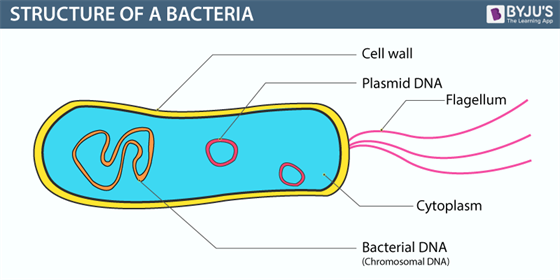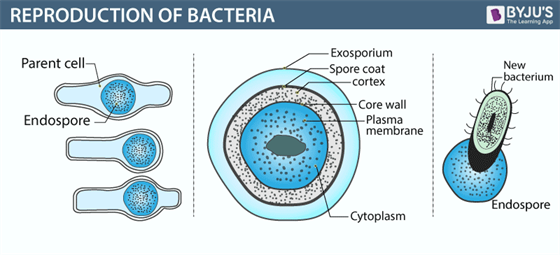One of the very first organisms to evolve on earth was probably a unicellular organism, similar to modern bacteria. Ever since then, life has evolved into a multitude of life forms over many millennia. However, we can still trace our ancestry back to this single-celled organism.
Table of Contents
- Definition
- Bacteria Diagram
- Ultrastructure of a Bacterial Cell
- Classification
- Reproduction
- Useful Bacteria
- Harmful Bacteria
Today, bacteria are considered as one of the oldest forms of life on earth. Even though most bacteria make us ill, they have a long-term, mutual relationship with humans and are very much important for our survival. But before we elaborate on its uses, let us know the structure of bacteria, its classification, and the bacteria diagram in detail.
Bacteria Definition
“Bacteria are unicellular organisms belonging to the prokaryotic group where the organisms lack a few organelles and a true nucleus”.
Also Read: Gram Negative Bacteria
Bacteria Diagram
The bacteria diagram given below represents the structure of a typical bacterial cell with its different parts. The cell wall, plasmid, cytoplasm and flagella are clearly marked in the diagram.

Bacteria Diagram representing the Structure of Bacteria
Ultrastructure of a Bacteria Cell
The structure of bacteria is known for its simple body design. Bacteria are single-celled microorganisms with the absence of the nucleus and other cell organelles; hence, they are classified as prokaryotic organisms.
They are also very versatile organisms, surviving in extremely inhospitable conditions. Such organisms are called extremophiles. Extremophiles are further categorized into various types based on the types of environments they inhabit:
- Thermophiles
- Acidophiles
- Alkaliphiles
- Osmophiles
- Barophiles
- Cryophiles
Another fascinating feature of bacteria is their protective cell wall, which is made up of a special protein called peptidoglycan. The components of bacterial cell wall forms an important basis upon which the bacteria can be divided. This particular protein isn’t found anywhere else in nature except in the cell walls of bacteria.
But few of them are devoid of this cell wall, and others have a third protection layer called capsule. On the outer layer, one or more flagella or pili is attached, and it functions as a locomotory organ. Pili can also help certain bacteria to attach themselves to the host’s cells. They do not contain any cell organelle as in animal or plant cell except for ribosomes.
Ribosomes are the sites of protein synthesis. In addition to this DNA, they have an extra circular DNA called plasmid. These plasmids make some strains of bacteria resistant to antibiotics.
Also Read: Gram Positive Bacteria
Classification of Bacteria
Bacteria can be classified into various categories based on their features and characteristics. The classification of bacteria is mainly based on the following:
- Shape
- Composition of the cell wall
- Mode of respiration
- Mode of nutrition
Also check: Bergey’s Classification of Bacteria
Classification of bacteria based on Shape
| Type of Classification | Examples |
|
Bacillus (Rod-shaped) |
Escherichia coli (E. coli) |
|
Spirilla or spirochete (Spiral) |
Spirillum volutans |
|
Coccus (Sphere) |
Streptococcus pneumoniae |
| Vibrio (Comma-shaped) | Vibrio cholerae |
Classification of bacteria based on the Composition of the Cell Wall
| Type of Classification | Examples |
|
Peptidoglycan cell wall |
Gram-positive bacteria |
| Lipopolysaccharide cell wall | Gram-negative bacteria |
Classification of bacteria based on the Mode of Nutrition
| Type of Classification | Examples |
|
Autotrophic Bacteria |
Cyanobacteria |
| Heterotrophic Bacteria | All disease-causing bacteria |
Classification of bacteria based on the Mode of Respiration
| Type of Classification | Examples |
|
Anaerobic Bacteria |
Actinomyces |
| Aerobic Bacteria | Mycobacterium |
Also Read: Difference between Bacteria and Virus
Reproduction in Bacteria

Bacteria follow an asexual mode of reproduction, called binary fission. A single bacterium divides into two daughter cells. These are identical to the parent cell as well as to each other. Replication of DNA within the parent bacterium marks the beginning of the fission. Eventually, cell elongates to form two daughter cells.
The rate and timing of reproduction depend upon the conditions like temperature and availability of nutrients. When there is a favourable condition, E.coli or Escherichia coli produces about 2 million bacteria every 7 hours.
Bacterial reproduction is strictly asexual, but it can undergo sexual reproduction in very rare cases.
Genetic recombination in bacteria has the potential to occur through conjugation, transformation, or transduction. In such cases, the bacteria may become resistant to antibiotics since there is variation in the genetic material (as opposed to asexual reproduction where the same genetic material is present in generations)
Also Read: Binary fission
Useful Bacteria
Not all bacteria are harmful to humans. There are some bacteria which are beneficial in different ways. Listed below are few benefits of bacteria:
- Convert milk into curd – Lactobacillus or lactic acid bacteria
- Ferment food products – Streptococcus and Bacillus
- Help in digestion and improving the body’s immunity system – Actinobacteria, Bacteroidetes, Firmicutes, Proteobacteria
- Production of antibiotics, which is used in the treatment and prevention of bacterial infections – Soil bacteria
Also Refer: Antibiotics
Harmful Bacteria
There are bacteria that can cause a multitude of illnesses. They are responsible for many of the infectious diseases like pneumonia, tuberculosis, diphtheria, syphilis, tooth decay. Their effects can be rectified by taking antibiotics and prescribed medication.
However, precaution is much more effective. Most of these disease-causing bacteria can be eliminated by sterilizing or disinfecting exposed surfaces, instruments, tools and other utilities. These methods include- application of heat, disinfectants, UV radiations, pasteurization, boiling, etc.
To know more about bacteria, its definition, the structure of bacteria, bacteria diagram, classification of bacteria, and reproduction in bacteria keep visiting BYJU’S website or download BYJU’S app for further reference.

Also Read:
Frequently Asked Questions
1. What are the different types of bacteria??
Bacteria can be divided into several types based on several characteristics such as shape, cell wall composition, mode of respiration, and mode of nutrition.
2. What is bacteria? How do you define bacteria?
Bacteria are prokaryotic unicellular organisms. They have a relatively simple cell structure compared to eukaryotic cells. They also do not possess any membrane-bound organelles such as a nucleus. However, do they possess genetic material (DNA or RNA) in the intracellular space called the nucleoid
3. How do bacteria reproduce?
Bacteria reproduce through a process called binary fission. In this process, a single bacterium divides into two daughter cells. These daughter cells are identical to the parent cell as well as to each other.
4. State 4 examples of bacteria.
- Streptococcus
- Bacillus
- Actinobacteria
- Proteobacteria
5. The study of bacteria is called?
The study of bacteria is called bacteriology.
6. What are the examples of acidophilic bacteria?
Acetobacter aceti and Alicyclobacillus acidiphilus are two examples of acidophilic bacteria.
Also check:


Good info
please state about eubacteria and archeabacteria
Read more about eubacteria and archaebacteria here.
Thank you so much byjus . This helped me a lot
Good Information Thanks to BYJU’S
THANK YOU .
Please tell me about kinds of Bacteria
Bacteria can be classified based on shape, mode of nutrition, respiration, the composition of the cell wall, etc. Based on these criteria, bacteria can be classified as bacillus, coccus or vibrio, etc., autotrophic or heterotrophic, aerobic or anaerobic, Gram + or Gram -. Read the above topic for detailed information.
Good info it’s REALLY helpful in my exam
Difference between Bacteria and Virus
Classify bacteria on the basic of oxygen requirements?
Yes it is really good 👌👌